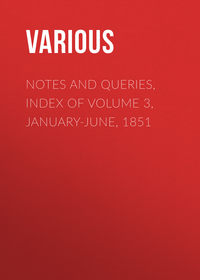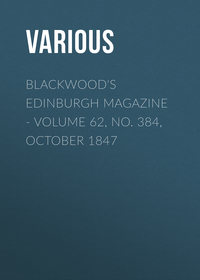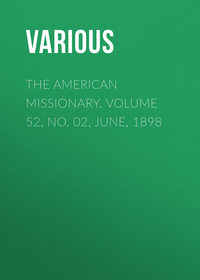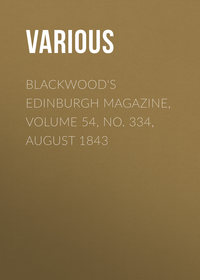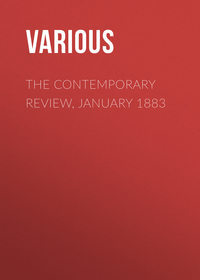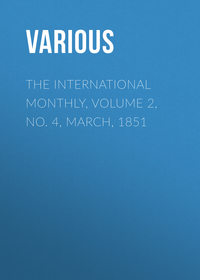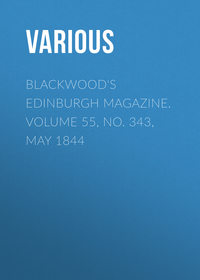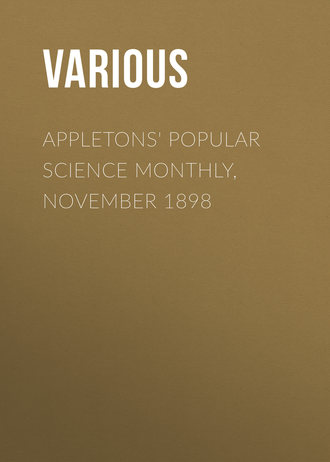 полная версия
полная версияAppletons' Popular Science Monthly, November 1898
L'Année Psychologique [18] of M. Alfred Binet and his colaborers in the Laboratory of Physiological Psychology of the Sorbonne, Paris, is now in its fourth year, and the four volumes present a compendium of the psychological studies and literature of the period they cover, the value of which will be appreciated by any one who has occasion to examine the work. The first volume was a book of 619 pages, with 33 figures; the second, of 1010 pages, 141 figures, and several plates; the third, of 825 pages, 103 figures, and numerous plates; and the present volume has 849 pages and 117 figures. The plan of all the volumes is the same; it is to present in full the labors of the laboratory, with original memoirs, and to give a condensed but adequate and classified summary of the world's literature of the year relating to the subject. The present volume contains twenty-seven original memoirs, mostly by Professor Binet and M. N. Vaschide, with others by M. B. Bourdon and Mr. A. Le Clère; about ninety reviews of books and papers, classified under sixteen heads, according as they relate to the physiology of the nervous system, the several senses, mental faculties and operations, movements, individual psychology and character, sleep, dreams, and pathological cases, and animal psychology; a bibliography, also classified, of 123 pages; and an index of authors, occupying 17 double-columned pages.
Prof. Cyrus Thomas has given, in his Introduction to the Study of North American Archæology,[19] a brief summary of the progress in the investigation and study of the subject which has been made up to the present time. The increased activity among students, the numerous explorations made, the accumulation of data and the flood of light thrown on questions relating to prehistoric North America since the publication of the last general work on it seemed to call for such a summary. While the author's chief object is to present and arrange the data so as to afford the student some means of bringing into harmony and utilizing the facts and materials at hand, yet, in view of the impossibility of presenting a full account of the archæological remains of the continent, and discussing all the questions connected with them in a single small volume, only those considered the best representatives of the leading types and those which best illustrate the arts, customs, and culture status of the former inhabitants are referred to. The movements and remains are treated under the three heads of the Arctic, Atlantic, and Pacific divisions; the first including the works of the Eskimos, the second those of the mound builders, and the third the curious variety of works scattered along the Pacific coast, and in Mexico and Central America, rising to great elaboration in the latter countries. Theories have to be considered, though they are all still uncertain, and Professor Thomas notices the various views which have been expressed as to the origin of the works and the people who executed them. He himself believes that they are all the work of the peoples who lived here when America was discovered, and are represented by the present Indians; that they are not of a very extreme antiquity; and that the continent was peopled by tribes who came down from the northwest through the region between Hudson Bay and the Rocky Mountains.
Of Nature books encouraging the study of the life around us we have an abundance – of some sorts, perhaps, a superfluity – and they have their uses, one of the chief of which is drawing people, who might otherwise never think of it, to the observation of natural facts, and to inquiry into their character and causes. Such books are fittingly complemented by the Handbook of Nature Study,[20] of D. Lange, of St. Paul, Minnesota, which teaches how system may be introduced into this occupation. In it, the author has undertaken to point out some of the material which may be made the basis of profitable lessons in Nature study, and to show how this material may be made available, and what the pupils may be taught about it. The author has arranged the matter of the subject of his teachings according to seasons and life communities. He begins at home in the spring, and directs the wanderings of the pupils to the waters, fields, and prairies, the roadsides and neglected corners, studying besides the plants and animals, the geological action of water, the flowers of the fields and the needs of neglected places, window flowers, and domestic animals. Then he goes to the woods – in spring, in summer, and in autumn – and their plant and animal life, the effect of all these upon the earth, and their relations to one another. Some practical precepts are given to teachers concerning the method of conducting the study of Nature.
In the presentation of his conception of The State[21] or the Elements of Politics, Prof. Woodrow Wilson has taken a comprehensive view. Designing a book for study and instruction, he has sought to set forth the evolution of existing systems of government from the beginning. Possessing no model, no text-book of like scope and purpose having apparently hitherto been attempted, he has had to make his own type; and, in the absence of anything else to refer the student to, has been obliged to include much that might otherwise have been omitted. The volume is consequently large; but this disadvantage, if it be one, is compensated for by the fact that the student has the whole subject before him. For his descriptions the author has chosen governments which are types of their several kinds. An indispensable prerequisite to studies of things of this sort is a knowledge of the constitutions of the states of classical antiquity; hence the institutions of Greece and Rome are studied: Greece, which furnished the spirit and inspiration under which the world has advanced; and Rome, which laid the foundations of modern jurisprudence. Before these, even, a glance at The Earliest Forms of Government, their Origin and Evolution, was required. Then, coming to modern systems, which are also traced in their historical development, "the government of France serves excellently as an example of a unitary government of one kind, and Great Britain equally well as an example of a unitary government of another kind; Germany exhibits a federal empire, Switzerland a federal republic of one sort, the United States a federal republic of another; Austria-Hungary and Sweden-Norway show the only two existing European types of dual monarchies." Russia might have been presented as having a place apart in European politics, but the book was full. The work has been prepared in the belief that "our own institutions can be understood and appreciated only by those who know other systems of government as well and the main facts of general institutional history." The accounts of the particular systems of government are followed by short chapters on the Nature and Forms of Government; Law, its Nature and Development; the functions and the objects of government; and summaries, in which the conclusion is expressed that law grows with the growth of the community, can not leap too far ahead of it, and must not lag behind it; and that "the method of political development is conservative adaptation, shaping old habits into new ones, modifying old means to accomplish new ends."
Mr. H. E. Parkhurst has made in his How to Name the Birds[22] a book on a different plan from the other books about birds that are now appearing so abundantly – not to rival them, but to serve as an introduction to their more general use. It is intended to aid the field ornithologist in determining an unknown species, by calling his attention to their more obvious features and those more distinguishable from a distance than those which observers using the ordinary bird books have to depend on as a means of recognition. Color is chiefly relied upon, and, as a further means of finding the birds, they are grouped by the seasons, when they may be seen in a given locality – the summer, winter, migrant, and permanent birds, and birds of prey. The first four groups are subgrouped according to color, and the larger color groups are further subdivided. Other devices and signs are contrived, so that a complete description of the bird, as it will appear to the amateur watching it from a little way off, is given in three or four lines. To this a brief comment is added regarding the nesting and habits of the bird. These descriptions are preceded by an analytical key similar to the botanical keys; and the study is aided by giving three pages of diagrams illustrating the distinctive areas of the bird's body, to which reference is made in describing the colors, stripes, and spots. The list comprises only those birds that are normally found within the territory described in the title as regular summer or winter visitants, as migrants, or as permanent species.
A very important contribution to the economy of city administration is the quarterly Supplement to Municipal Affairs, June, 1898, in which the late superintendent of street cleaning in the city of New York, George E. Waring, Jr., presents his observations on street-cleaning methods in European cities, and general reports of his own work in that line. The observations in Europe, made in the summer of 1896, in a special study of the subject, for the information and improvement of Mr. Waring's own department, include accounts of the conditions as to cleanliness and the methods of doing the work in Vienna, Budapest, Munich, Berlin, Cologne, Brussels, London, Birmingham, Paris, Turin, and Genoa. Mr. Waring finds that the regulations under which the streets are really kept clean in those cities are no better than ours; "but there is the immense difference that in Europe laws and ordinances mean something and are executed, while here they are treated as mere matters of form." The reports of Mr. Waring's own work in New York embrace a review of the general operations of the department, the report of the snow inspector, and an account of the highly successful plan for the adjustment of labor questions instituted by Mr. Waring.
Mr. Lauros G. McConachie, in the study and development of legislative methods which he publishes under the title of Congressional Committees (T. Y. Crowell & Co., New York, $1.75), assumes that a complete breakdown of parliamentary machinery took place on the floors of Congress under the sudden and vast augmentation of legislative burdens which our senators and representatives had to confront after the civil war. Two schools of reformers came to the front, one of which held up the British parliamentary system as a model and directed attention abroad in the search for light; while the other stood up for the defense of American legislative methods as developments of American political conditions. The author has sought a mean between these schools, and has tried to glean from contemporary debates, memoirs, newspapers, and other records the reasons assigned for each innovation as it has entered and enlarged the codes, and has taken the testimony of contemporary legislators upon the conditions prevailing in successive stages in the history of the national House and Senate. Among the lessons presented by the book are those of the tremendous power wielded by the speaker of the House of Representatives and of "other anomalies in a supposed elective folk congress."
Whittaker's Mechanical Engineer's Pocket Book, prepared by Philip R. Björling, if it does not contain everything, contains a great many facts and formulas concerning matters on which the mechanician is often called upon to seek immediate information, a considerable proportion of which are not easily subject to systematic classification. Among the one hundred and thirty formulas and processes are those relating to the flow and force of water and wind, the pressure of gases and the air, the weight, proportions, and strength of parts of machinery; stresses, rate of delivery of elevators, etc., gauges, tables of areas and circumferences, squares, cubes, fourth and fifth powers and roots, and items which can be indicated only by viewing them in detail. It is a valuable and indispensable companion for the mechanical engineer. The Macmillan Company. Price, $1.75.
M. J. Costantin conceives that science consists in something more than the mere accumulation, description, and classification of facts, with which too many persons confound it, and that the important thing is what the facts teach, and, as related to it or as what may help to find it out, the theories that may be deduced from them. He applies this principle to the evolution of plant life in his book Les Végétaux et les Milieux Cosmiques (Plants and Cosmic Media) – adaptative evolution, which is essentially a study of the operation of the various material factors of the environment on growth and development. "Guided by Goethe's ideas, he invites us to witness the incessant variations of organized existence everywhere visible in Nature," under the influence of cold and heat, light, gravity, and the aquatic medium, hoping in these studies to find new and decisive arguments in favor of transformist conceptions. He aims to show how the new characteristics produced by changes in the influence of these factors to which plants are subjected may be fixed and gradually become hereditary. (Published by Félix Alcan, Paris, in the Bibliothèque Scientifique Internationale.)
Mr. A. G. Elliot's little work on Industrial Electricity– a translation and adaptation from the French of Henry D. Graffigny – is the first and introductory volume of an electro-mechanical series published by Whittaker & Co., London, and the Macmillan Company, New York. The editor, in introducing the volumes, expresses the belief that there is room for them because they explain in very clear and non-mathematical language the many and various applications of electricity. Many thousand copies of the original French editions have been sold. The present volume is divided into short chapters, each dealing with a separate branch of practical electricity-its nature, the units, magnetism and induction, practical measurement, chemical generators, accumulators, dynamo-electric machinery, electric light, electricity as a motive power, electric chemistry and electro-plating, bells and telephones, and telegraphs. In the succeeding volumes of the series the more important branches of the subjects touched upon here will be treated separately and in detail.
Franklin Story Conant was born in Boston in 1870; was educated in the public schools of New England, at the University of South Carolina, and at Williams College; and was a Doctor of Philosophy, Fellow, and Adam T. Bruce Fellow in Johns Hopkins University. He showed great appetency for biological investigation and devoted himself to it, at Baltimore, Beaufort, N. C., Wood's Hole, and in Jamaica. He published a few papers of mark, and would have published many more if he had lived. He went to Jamaica in June, 1897, to continue his investigations, and worked for nearly three months on the development and on the physiology of the sense organs of the Cubomedusæ. After the death of the director of the expedition, Dr. J. E. Humphrey, he took the burden upon himself, and labored faithfully till he contracted yellow fever; returned to Boston, and died there September 13, 1897. His associates of Johns Hopkins University have published as a memorial volume of him his dissertation on The Cubomedusæ, which he presented at the examination for the degree of Doctor of Philosophy in June, 1897, accompanied by a brief notice of his life and a portrait.
Frederick H. Ripley and Thomas Tapper, authors of the Natural Music Course, have arranged A Short Course in Music, consisting of two books, for use in schools in which the more complete course is deemed unnecessary or impracticable. In both books familiar songs are made the basis of elementary music instruction. In these songs the compositions of the best song writers are represented. Exercises in two and three parts in simple form are included in the course. A brief summary of elementary theory is inserted in the appendix. Few definitions are given, the thought of the learner being so directed as to render them either unnecessary or obvious. In the cultivation of tone and expression the authors insist that it is the mind rather than the vocal organs that at first needs attention. "If the pupil hears the ideal tone he will almost instinctively imitate it." A number of portraits of composers are given in connection with the songs. (American Book Company. Price, 35 cents.)
Mr. Alfred Still, believing that there was still room for a small book in which the principles determining the behavior of single-phase alternating currents under various conditions should be considered less from the point of view of the man of science than from that of the engineer, offers Alternating Currents of Electricity and the Theory of Transformers for the place. The book has been written, not only for engineering students, but also for those engineers who, while having extensive practical knowledge of the subject, are yet anxious to get a correct elementary idea of the leading principles involved. Graphical methods are used throughout, and the introduction of mathematics has been carefully avoided. (Published by Whittaker & Co., London; The Macmillan Company, New York. Price, $1.50.)
A paper by A. B. Stickney, president of the Chicago Great Western Railway Company, on The Currency Problems of the United States in 1897-'98, takes the ground that currency is the creature of commerce; that legislation has nothing to do with it; that its problems are purely economical; and that the only thing that can be done for it is to improve the machinery of exchanges.
A valuable and useful publication is New York State Library Bulletin, Legislation, No. 9, containing a summary of legislation by States in 1897. This is the eighth annual number of the series, and its purpose is to show at a glance what laws have been passed by States on any subject, except those of purely local interest. The summaries, though concise, so well cover the principal points of the laws cited that consultation of the text of the laws may often be dispensed with. Constitutional amendments receive special treatment. The references in the present bulletin cover thirty-six States and three Territories.
Two memoirs, published under one cover by the Peabody Institute of American Archæology and Ethnology, relate to explorations by George Byron Gordon in two districts of Honduras, affording relics different in character. The work at the ruins of Copan having been suspended during 1896 and 1897 by some act of the Government of Honduras, Mr. Gordon had to turn his attention elsewhere, to explorations the results of which are given under the titles of Researches in the Uloa Valley and Caverns of Copan, Honduras. The investigations in the Uloa Valley afforded a rich fund of objects of interest and of novel character – pottery adorned with elaborate and remarkably artistic designs, stone images, whistles, terra-cotta stamps, and only one idol. Human remains, of the most meager description, in connection with the pottery furnish reasonable evidence of burial places, but, being only crumbling fragments of bone, are too minute to supply any information respecting the form of burials or the relative position of the objects associated with them. The conclusions are drawn that the valley was at one time well populated, but not for any length of time occupied by the people whose ruined buildings of stone are found in the region up to southern Mexico, and that it was visited by several distinct peoples in ancient times. Some mounds covered with stone were discovered which deserve further investigation. Five caves of different size and character, described in the second memoir, were explored near Copan, and afforded objects peculiar to themselves and evidences of sepulture. They were very dusty, although stalactites had formed in some of them, and, although undoubtedly used by man many centuries ago, they do not seem to indicate a constant occupation for an extended period of time, or to furnish evidence of an extreme antiquity of man in the region. The most striking feature about them is probably the entire difference in character of the pottery from that found at Copan, only a few miles away, and its want of resemblance with the pottery of any other locality with which the author is familiar.
A series of Bulletins, Some Miscellaneous Results of the Work of the Division of Entomology, of the United States Department of Agriculture, is intended to furnish such material as was formerly published in Insect Life, presenting the results of observations made in the office of the bureau which are not extensive enough upon any one topic to form an independent and complete bulletin. The second number contains notices by different authors, mostly connected with the bureau, on twelve insects predatory on economical plants, with numerous "general notes" and correspondence.
Under the Stars, and Other Verses, is a small collection of ballads, relating chiefly to naval fights, by Wallace Rice and Barrett Eastman, published by Way & Williams, Chicago. It is dedicated "to the wider patriotism," and appears well adapted to inflame the martial spirit, which is in this country already excited to an extremely unhealthy extent.
PUBLICATIONS RECEIVED
Agricultural Experiment Stations. Bulletins and Reports. Cornell University: No. 150. Tuberculosis in Cattle and its Control. By James Law. Pp. 30; No. 151: Gravity or Dilution Separators. By H. H. Wing. Pp. 12 – Purdue University: No. 72. Field Experiments with Wheat. Pp. 12. – United States Department of Agriculture. Biological: No. 9. Cuckoos and Shrikes in their Relation to Agriculture. By F. E. L. Beal and S. D. Judd. Pp. 26: No. 10. Life Zones and Crop Zones of the United States. By C. Hart Merriam. Pp. 79; No. 11. The Geographic Distribution of Cereals in North America. By C. S. Plumb. Pp. 24; Botany: No. 20. Principal Poisonous Plants in the United States. By V. K. Chesnut. Pp. 60.
Alexander, Archibald. Theories of the Will in the History of Philosophy. New York: Charles Scribner's Sons. Pp. 353. $1.50.
Allen, Alfred H., and Leffmann, Henry. Commercial Organic Analysis. Third edition. Vol. I. Philadelphia: Blakiston's Son & Co. Pp. 557. $4.50.
Babbler, The. Semimonthly. June and July, 1898. New York: E. Rock, 406 Fourth Avenue. Pp. 8. 10 cents. $2 a year.
Baillière, J. B., et Fils, 19 Rue Hautefeuille, Paris. Revue Mensuelle de Bibliographie Scientifique (Monthly Review of Scientific Bibliography), August, 1898. Pp. 20.
Carter, J. M. G. Advances in the Domain of Preventive Medicine. Waukegan, Ill. Pp. 13.
Chemical Publishing Company, Easton, Pa. Catalogue. Pp. 26.
Columbia University Bulletin, June, 1898. Pp. 102, with plate.
Creighton, J. E. An Introductory Logic. New York: The Macmillan Company. Pp. 392. $1.10.
Drake, N. F. A Geological Reconnaissance of the Coal Fields of the Indian Territory. Leland Stanford, Jr., University, Palo Alto, Cal. Pp. 96.
Fitz-Maurice-Kelly, James. A History of Spanish Literature. New York: D. Appleton and Company. (Literature of the World Series.) Pp. 423. $1.50.
Holden, Edward S. The Earth and Sky. A Primer of Astronomy for Young Readers. (Appletons' Home-Reading Series.) New York: D. Appleton and Company. Pp. 76, with plates. 28 cents.
Hering, Rudolph, New York. Dilution Process of Sewage Disposal. Pp. 9. – Bacterial Processes of Sewage Disposal. Pp. 14.
Industrialist, The. Ten times a year. June, 1898. Kansas State Agricultural College, Manhattan. Pp. 80. $1 a year.
Iowa Geological Survey, Vol. VIII. Annual Report for 1897, etc. Samuel Calvin, State Geologist. Pp.427.
Japan-American Commercial Journal. Monthly. Tokyo (Japan) Commercial and Industrial Association. (English and Japanese.) Pp. 80.
Jordan, David Starr. Lest we Forget (address to graduating class). Pp. 36. – Description of a Species of Fish (Mitsukurina owsteni) from Japan, the Type of a Distinct Family of Lamnoid Sharks. Pp. 8, with plates.
Kindergarten. The, Review. Monthly. Springfield, Mass.: Milton Bradley Company. Pp. 64. $2 a year.
Lambert, P. A. Differential and Integral Calculus; for Technical Schools and College. New York: The Macmillan Company. Pp.245. $1.50.





